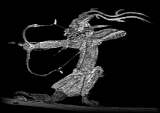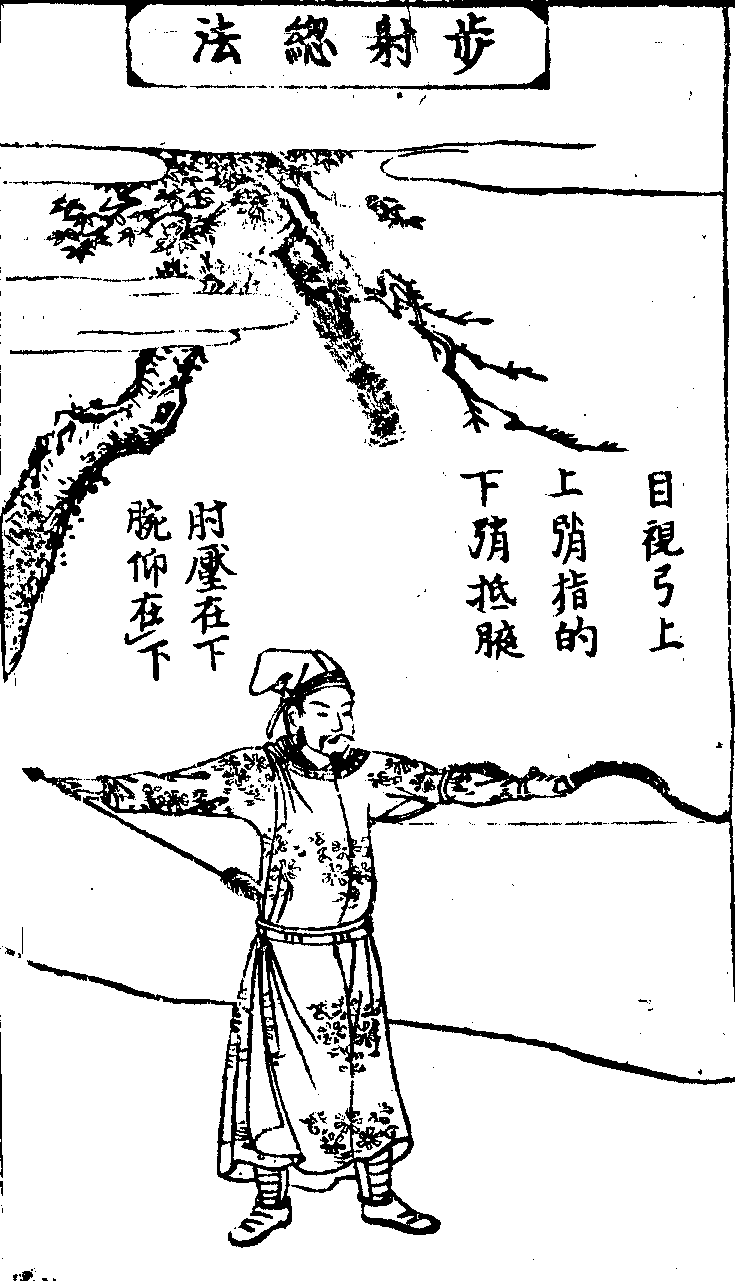

The Archery Tradition of China
© Stephen Selby, 1997
Re-printed with permission from
INSTINCTIVE ARCHER
MAGAZINE
Cast about in your memory for what you know about oriental archery.
If, like mine, your mental picture tends to move from west to east, rather than crossing the Pacific, your mind’s eye might start with the tradition of the Magyars and Turks, then look back over the Steppes Tartars (the Parthian shot) into the grasslands of Central Asia, swooping past the Mongol hordes. Next, Korea, whose long history of respect for archery has bred Olympic champions, and finally, you would certainly have heard of the Japanese traditions of Kyudo and Kyujitsu.
I’d bet you a dollar to a dime that as you reached China, your mind drew a blank. What can you recall about archery among a great nation of two billion people with a written history spanning four thousand years? If it is not a great deal, then don’t blame yourself. A great tradition has existed in China, and it has died. But literature and archaeology have left enough strands of DNA for the tradition to be brought to life again. This is the project that I am engaged in present.
The earliest records of Chinese cultural history come down to use in the form of folk-lore. Some clues also survive in the most ancient forms of the Chinese writing system, in which the written word consisted of pictures combined into symbols. From these clues, a rather astonishing picture of ancient Chinese archery emerges. Some 3,500 years ago, there was a shamanistic archery cult in China. The shamans and rulers performed archery rituals to pray for rain, reduce floods and keep barbarians from Chinese lands. Famous among the shamans were the clan called ‘Yi’, whose founder, according to Chinese folklore, shot from the sky nine suns which appeared causing a drought and famine.
In the earliest Chinese royal dynasties, archery had an important place both in mystic ritual and in war. It was a compulsory subject, together with ritual, music, charioteering, reading and arithmetic, in the schools which trained the Chinese nobility.
Some 1,000 years later, over 2,000 years before the our times, archery was still an important part of imperial court ritual. Confucian scholars transformed the ancient shamanistic ritual into a shooting ritual designed to symbolise Confucian virtue.
Around 2,500 years ago, the crossbow, which had appeared in China in very early times, went through a major technological development. With the invention of a precision-engineered bronze crossbow mechanism by Clansman Qin of Chu, the crossbow became capable of delivering a heavy load, and for the first time it fired a heavy bolt with such force that an graduated sight reticule and artillery method could be developed. Although that didn’t end the military role of the bow and arrow, it did put archery into the hands of the ordinary infantryman, rather than the noble archer trained of years in natural, bare-bow shooting. This had a significant influence, de-mystifying and popularising the practice of archery in China.
The inventive talent and technological skill of the Chinese people might have put an end to the bow and arrow in the battlefield had it not been for the rise of the Huns in Central Asia. The Chinese army, skilled in fighting in the plains with infantry and war chariots, were confronted with skilled archers on horseback. Just as the crossbow started to become a significant weapon of war, the enemy moved the goal-posts. King Wuling of Zhao realised that the Chinese army had no choice but to abandon their traditional infantry formations now armed with crossbows, take off their flowing Chinese robes, don the short tunics worn by the Hun horsemen, and learn to shoot with a bow from horseback.
From that time on, skill in horseback archery combined with high-powered crossbows for sieges (some requiring a ox and windlass to draw them!) and naval engagements formed the backbone of Chinese military archery practice. This basic tactical mix continued over the next thousand years during which China’s main strategic concern was with mounted horsemen (and women) on her land borders.
Another significant development came in the Tang Dynasty, when the Empress Wu Ze Tian decreed in about 720 AD that cavalry and infantry archery was to become a compulsory subject in military examinations. This spurred an academic interest in archery technique and resulted in the publication of some of the great Chinese archery manuals which have survived to this day. Training in archery remained a major concern in the Ming Dynasty (1368–1644) and the following Qing Dynasty (1644-1911). But in the 1901, the Chinese court, faced with growing military losses at the hands of aggressive foreign colonial powers, finally to conceded that ‘Tests of strength with the bow, infantry and cavalry archery have no place in military practice and in the present day and age are no longer useful... ...they shall be permanently discontinued.’ Thereupon, archery was deleted from the examination syllabus.
The construction technique of the Chinese bow changed little from the days of Confucius to the time when the last traditional Chinese bowyers went out of business in about 1940. The bow was built from a wooden (or sometimes bamboo) core, with ox-horn on the belly to take compression and sinew on the face of the bow to resist extension.

The effect of this combination was that unstrung, the bow would double back into a ‘C’ shape, as you can see in the illustration above (after Tan Dan-jiong).
The assembled wood, horn and sinew was bound tightly with silk thread and finally given a coat of lacquer to keep moisture out. Often the bows were decorated with snakeskin or birch-bark, and the grip was bound with ray skin (like the grip of a Japanese samurai sword.) The form of the bow didn’t remain constant throughout three thousand years; but it did not vary too much either. Up to the Ming Dynasty, bows were about two-thirds of body-height; but in the Qing Dynasty, they became larger, and bows were commonly about the same size as modern western recurves at around 66 inches.
Chinese literature contains a lot of tales of extraordinary draw-weights for bows. But technical writings stress that a heavy draw-weight was not desirable, and could actually be counter-productive. For military purposes, a weight of fifty to sixty pounds was adequate, and for civil archery, a much lower weight was drawn. Military examinations tested strength to draw up to ninety pounds: but this was a test of physique rather than archery: even the bows for ‘strength drawing’ were different from those used for archery.
Likewise, technique was not static, and many fashions developed. But discussions of technique centred around the elements of a prescribed form of archery set down in about 150 BC in the Han Dynasty. The ancient shamanistic magic left its mark in a demand to place the feet at right-angles. This form persisted up until the Ming Dynasty, when it was replaced by a foot-position not too different from the open stance of today.
In contrast to western, Japanese and Korean archery, archers always shot with one or both legs flexed at the knee and spread from the waist. For those who know Chinese martial arts, this is the classic, basic military stance. Such a stance is necessary to promote the proper integration of breathing, blood-flow, muscle tension and concentration known as ‘Qigong’ which has always been an integral element of Chinese archery. It is in fact correct to describe Chinese archery as a form of Qigong.
Chinese archery manuals stress two processes: that of gaining a firm stance (known as ‘gu’) and of maintaining maximum concentration (known as ‘shen’). Both are developed through a series of movements progressing from a low-tension start to a high-tension release at full draw (called ‘gou’.) Here is an illustration from a Ming Dynasty manual by Chen Zong-you, the ‘History of Archery in Eight Volumes’ (Courtesy of the National Library of the People’s Republic of China) .
 The string hand position was what we now call the ‘Mongolian Release’. But some Chinese authors advocated what
they called the real ‘Chinese Release’ in which the string was held by the thumb
(protected by a ring), and supported by the middle finger, with the forefinger pointed
upward along the string. (This might sound eccentric, but after I tried it, I could never
go back to any other position.) After the release, the string hand naturally falls back
and out, so that the end of the firing procedure leaves the archer with both arms
extended, and in the next movement, the archer takes his next arrow ready to nock it on
the string like the picture on the left.
The string hand position was what we now call the ‘Mongolian Release’. But some Chinese authors advocated what
they called the real ‘Chinese Release’ in which the string was held by the thumb
(protected by a ring), and supported by the middle finger, with the forefinger pointed
upward along the string. (This might sound eccentric, but after I tried it, I could never
go back to any other position.) After the release, the string hand naturally falls back
and out, so that the end of the firing procedure leaves the archer with both arms
extended, and in the next movement, the archer takes his next arrow ready to nock it on
the string like the picture on the left.
After the Japanese occupation of China in the Second World War, the art of traditional archery had died out, despite some efforts by the Nationalist Government (1912–1949) to revive it. Now there is no-one in China practising the art. I am preparing a book on all aspects of Chinese archery to be published next year. I hope that the people of China will once again take pride in the three-thousand-year-old tradition of Chinese archery.